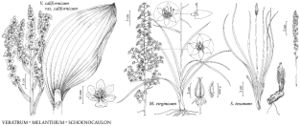Difference between revisions of "Veratrum californicum var. californicum"
imported>Volume Importer |
imported>Volume Importer |
||
| Line 66: | Line 66: | ||
|publication year= | |publication year= | ||
|special status=Illustrated;Endemic | |special status=Illustrated;Endemic | ||
| − | |source xml=https:// | + | |source xml=https://bitbucket.org/aafc-mbb/fna-data-curation/src/2e0870ddd59836b60bcf96646a41e87ea5a5943a/coarse_grained_fna_xml/V26/V26_60.xml |
|genus=Veratrum | |genus=Veratrum | ||
|species=Veratrum californicum | |species=Veratrum californicum | ||
Latest revision as of 21:16, 5 November 2020
Panicle usually branched nearly to tip, ± loosely flowered; bracts in unbranched portion ovate-elliptic, mostly less than 1 cm, shorter than flowers. Tepals elliptic to oblong-ovate, 8–15 mm. 2n = 32.
Phenology: Flowering summer–early fall.
Habitat: Moist to wet, marshy sites
Elevation: 1000–3500 m
Distribution

Ariz., Calif., Colo., Idaho, Nev., N.Mex., Oreg., Utah, Wash., Wyo.
Discussion
Smaller-flowered plants from Colorado and New Mexico have been called Veratrum tenuipetalum; except for flower size, which is at the lower end of the species range, these plants are congruent with V. californicum var. californicum.
N. Chiariello et al. (1980), using the snow-bank-emergent characteristics of Veratrum californicum, documented that the plants differing in open versus closed bud morphologies also have different leaf areas, internal temperatures, and rates of early expansion growth. These differences in life-history characteristics are inferentially similar to those of other alpine and northern Veratrum species.
Selected References
None.
